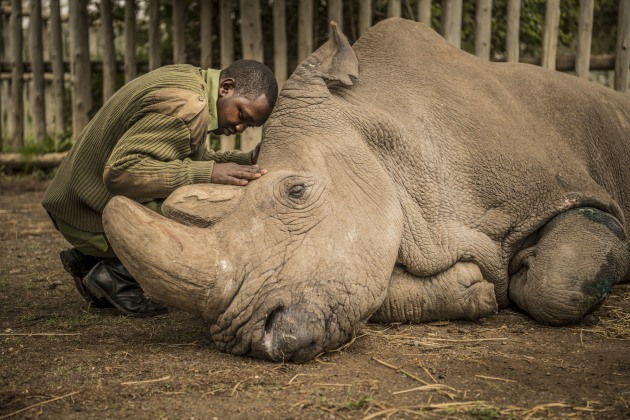Farewell to the last of a species
Joseph Wachira, 26, comforts Sudan, the last male northern white rhino on the planet, moments before he passed away at Ol Pejeta Conservancy in northern Kenya. I made the heartbreaking journey back to Kenya to say goodbye to Sudan, the world's last male northern white rhino. I met Sudan nine years ago after I heard about a plan to airlift four of the world’s last northern white rhinos from a zoo in the Czech Republic to Kenya. It sounded like a storyline for a Disney film of captive animals returning to the wild dusty plains. In reality, it was a desperate, last-ditch effort to save a species. At the time, there were only eight of these rhinos left, all living in captivity.

When I saw this gentle, hulking creature in the Czech snow, surrounded by smokestacks and humanity, it seemed so unfair. He looked ancient, part of a species that has lived on this planet for millions of years, yet could not survive mankind.
I remember so clearly when Sudan first set foot on the African soil. The skies darkened and torrential rains came moments after we arrived. He put his head in the air to smell the rains and immediately rolled around on the ground. It was his first mud bath since he left the continent as a two-year-old, taken from Sudan, the country with which he shares his name. That Sudan was moved to the Dvůr Králové Zoo may have saved his life; the last known wild rhinos were poached on the border of the Democratic Republic of the Congo in 2004.
Moments before he died, Sudan was surrounded by love, together with the people who committed their lives to protecting him and giving him the good life he enjoyed. There were the people from the Dvůr Králové Zoo, and his six dedicated keepers from Ol Pejeta, who spent more time with him than their own children. Veterinarians and other people from Kenya Wildlife Services were present as well. Most of them had been crying for days. I gave Sudan one last scratch on his ear. He leaned his heavy head into mine and the skies opened up just as they had when he arrived here nine years ago. He perked his head up in the pouring rain. All was silent except for one go-away-bird.
Poaching is not slowing down. It’s entirely possible, even likely, that if the killing continues, these rhinos—along with elephants and a host of lesser-known plains animals—will be functionally extinct in our lifetime.
My hope is that Sudan’s legacy serves as a catalyst to awaken humanity to this reality. Sudan’s death could mean the extinction of his species, though scientists are considering other options involving two remaining females, including stem cell procedures and harvesting eggs. But if there is meaning in Sudan’s passing, it’s that all hope is not lost. This can be our wake-up call. In a world of more than 7 billion people, we must see ourselves as part of the landscape. Our fate is linked to the fate of animals.
About Ami Vitale

Ami Vitale's journey as a photographer, writer, and filmmaker has taken her to over 90 countries where she has witnessed civil unrest and violence, but also surreal beauty and the enduring power of the human spirit. She has lived in mud huts and war zones, contracted malaria, and donned a panda suit – all in keeping with her philosophy of “living the story.” She is an Ambassador for Nikon and a contract photographer with National Geographic magazine, and has garnered prestigious awards including multiple prizes from World Press Photos, the International Photographer of the Year prize, the Daniel Pearl Award for Outstanding Reporting, and named Magazine Photographer of the Year by the National Press Photographer’s Association, among others.
Vitale now comes home to Montana in between making films and shooting stories about the planet’s most pressing issues, including wildlife on the edge of extinction, climate change-precipitated migration, and the struggles and triumphs of the human spirit. She lectures and teaches workshops throughout the Americas, Europe, and Asia, and her work is exhibited in museums, galleries, and private collections worldwide. She is a founding member of Ripple Effect Images – a collective of scientists, writers, photographers, and filmmakers with a mission of creating powerful stories illustrating the very specific issues women in developing countries face.
After more than a decade covering conflict, Vitale couldn’t help but notice that the less sensational, but equally true, stories were often not getting told: the wedding happening around the corner from the revolution, triumphs amidst seemingly endless devastation. As a result, she re-committed herself to seeking out the stories within and around “the story,” and remaining independent, so that she would have the freedom to shoot what she believed deserved to be shared.
Website: amivitale.com
Instagram: amivitale
Facebook: amivitale
Twitter: amivee
Supporting the work of Ol Pejeta Conservancy

Get more stories like this delivered
free to your inbox. Sign up here.
